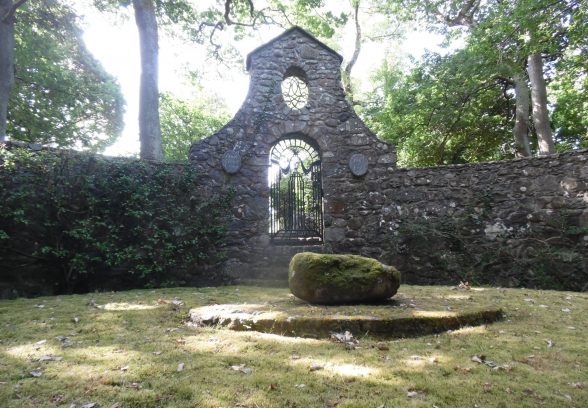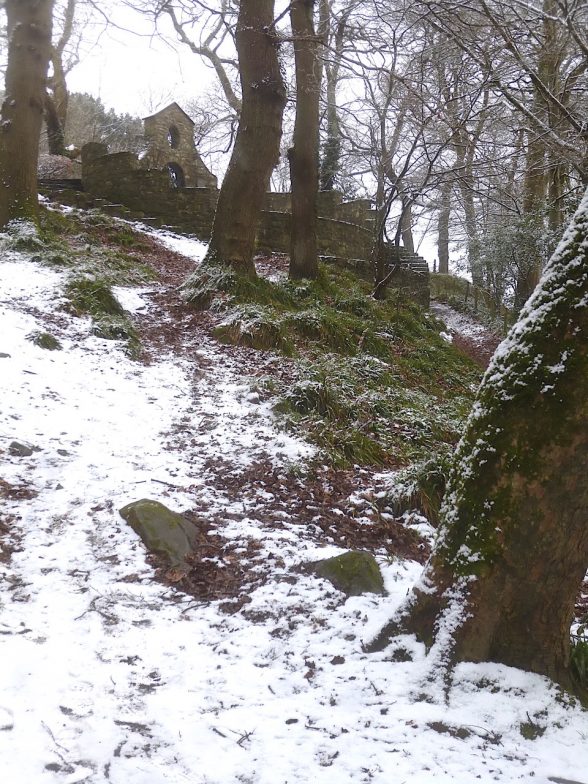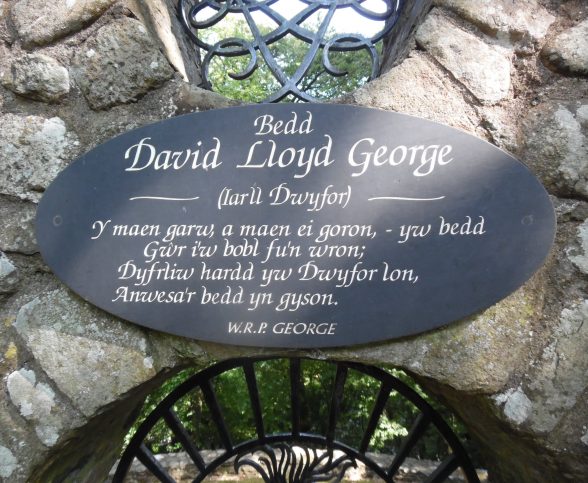This website uses cookies
This website uses cookies to enable it to function properly and to analyse how the website is used. Please click 'Close' to accept and continue using the website.



© David Hillas
July 2020 - The Lloyd George Memorial, Llanystumdwy
Clough Williams-Ellis (1946)
A circle or oval on a steep declivity is hard to design, the more so if it has to harbour a solemn enclosure. What height should the encircling walls have? If there is to be a level surface within, they must be shallow at the top but deep and strong at the bottom, where they must sustain the enclosure against slipping down the slope. How are they to drop? If they are not just to slide, they must step, but where and in what increments? And if the visitor is to make sense of the whole all round, outside as well as inside, there must be stairs from top to bottom. If they are separate, that will detract from the unity of the whole. How much better to clamp them on to the sides of the enclosure, strengthening the walls and prompting one to touch as well look!
These were the issues Clough Williams-Ellis (1883-1978) solved when he created the deceptively simple-looking grave and memorial to David Lloyd George in the woods outside the Welsh village of Llanystumdwy. At the time, politician and architect alike were as out of fashion as they could be. Lloyd George died in 1945, just months before the end of the Second World War. He had asked to be buried not in Westminster Abbey but by the banks of his beloved Dwyfor river, where he had played as a boy and came back in his retirement to sit and watch the water. His friend Clough designed the memorial soon after. Materials and labour were desperately short. But it seems to have been built quickly and opened quietly – in March 1946.

© Andrew Saint
Yet this site, seldom remembered today, is surely one of the most moving memorials anywhere. In the tourist season a few people stroll across to it from the back of the little Lloyd George Memorial Museum nearby, via a pair of grandiose gates added by Clough in the early ‘50s. We were there, more intrepidly, in February 2018, the notorious Beast from the East month. The museum was tight shut. We parked by the bridge and walked a few yards along the lane. To the left, we were beckoned into a spinney dropping down to the river by a short level path ending at an archway. The light snow clinging to the bare trees and powdering the path, paved with cobbles from the beach at Criccieth, added to the magic.
The arch is marked by one of those shaped gables Clough made his own, Dutch-Afrikaans in origin maybe, certainly not Welsh. But its material, local rubble, is amply Welsh and gives it weight. It is pierced twice. Above comes an oval opening with pretty ironwork in which the pattern DLG can just be discerned. Below is the entrance gate, of open ironwork again, featuring a flaming urn yet also strangely anthropomorphic. An example of Clough’s notorious ‘whimsy’? Lloyd George was not unknown for his sense of humour. Or perhaps just a note of sprightliness before one descends to the gravity of death. Over the gate is a slate panel with some lines from a poem by W. R. P. George, the politician’s nephew. Added later, it mars the austerity of rubble and ironwork.

© David Hillas
From the gate a couple of steps drop down into the simple enclosure. In the centre of the circumference, slightly raised, is a large stone on which Lloyd George used to sit and watch the river. Originally there were no words, but again tasteful slate panels were later affixed to the back of the arch. It’s a shame, but otherwise one might not know what this place is about. The only movement is provided by the walls stepping down in four hefty jumps to a new calm level at the base. It is all modestly and consummately done. Outside again, there are just the embracing steps, then a sharp drop of twenty yards or so through the trees to the rushing water that breaks the silence.
Fame is a fickle business. Clough Williams-Ellis is warmly regarded again nowadays, chiefly on account of Portmeirion, not that far from Llanystumdwy. But he is seldom taken for a serious architect. When you look for it, there is a plenty of seriousness to be found in his writings and work besides the Lloyd George Memorial. The belief that we should all enjoy architecture is serious enough – too serious, it seems, for most architects to engage with.
As for Lloyd George, who outside Wales esteems him today? Yet this was the man who fought like a trojan to bring in old-age pensions and national insurance, and by many accounts saved Britain from crumbling during the First World War. He can reasonably be rated the second greatest prime minister of the twentieth century. The ‘Welsh wizard’ was tricky of course, and ruthless, and inconsistent – as was Churchill. His reputation was blotted by personal infidelities and by corruption scandals in the early ‘20s. But he carried on doughtily at the head of an increasingly marginalized Liberal Party. A speech of his helped Churchill succeed Chamberlain in 1940.
In short, Lloyd George was a great man. Despite flaws there was a nobility to him, even a modesty too, attested by the burial place he chose in his native village. It rewards a visit – and reflection while you are there.
Click here to see Williams-Ellis discuss his designs for the memorial, in the BBC documentary ‘A Love Affair with Life: Clough Williams Ellis, Architect and Portmeirion’ (first broadcast in January 1971).
Andrew Saint was the General Editor of the Survey of London between 2006 and 2015. His books include Richard Norman Shaw; The Image of the Architect; Towards A Social Architecture; and Architect and Engineer: A Study in Sibling Rivalry.
The Building of the Month feature is edited by Dr. Joshua Mardell.
Look for past Buildings of the Month by entering the name of an individual building or architect or browsing the drop down list.

Become a C20 member today and help save our modern design heritage.